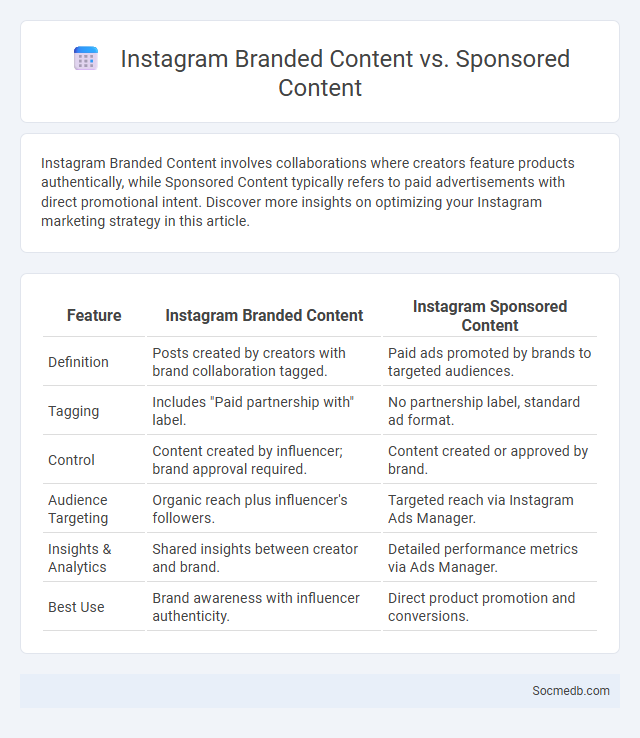
Photo illustration: Instagram Branded Content vs Sponsored Content
Instagram Branded Content involves collaborations where creators feature products authentically, while Sponsored Content typically refers to paid advertisements with direct promotional intent. Discover more insights on optimizing your Instagram marketing strategy in this article.
Table of Comparison
| Feature | Instagram Branded Content | Instagram Sponsored Content |
|---|---|---|
| Definition | Posts created by creators with brand collaboration tagged. | Paid ads promoted by brands to targeted audiences. |
| Tagging | Includes "Paid partnership with" label. | No partnership label, standard ad format. |
| Control | Content created by influencer; brand approval required. | Content created or approved by brand. |
| Audience Targeting | Organic reach plus influencer's followers. | Targeted reach via Instagram Ads Manager. |
| Insights & Analytics | Shared insights between creator and brand. | Detailed performance metrics via Ads Manager. |
| Best Use | Brand awareness with influencer authenticity. | Direct product promotion and conversions. |
Understanding Instagram Branded Content
Instagram Branded Content refers to posts or stories created by influencers or creators that feature products or services from brands, clearly labeled to comply with advertising transparency guidelines. It leverages the influencer's audience to enhance brand visibility and trust through authentic promotion, driving higher engagement rates compared to traditional ads. Understanding Instagram's Branded Content tools, such as the "Paid Partnership" tag, allows marketers to track performance metrics and ensure compliance with platform policies.
What Is Sponsored Content on Instagram?
Sponsored content on Instagram refers to paid posts or stories created by influencers or brands to promote products, services, or campaigns. These posts are clearly labeled as "Sponsored" or "Paid Partnership" to ensure transparency and comply with advertising regulations. Sponsored content leverages influencer reach and engagement to target specific audiences, driving brand awareness and sales through authentic storytelling.
Branded Content vs Sponsored Content: Key Differences
Branded content integrates your brand's values and storytelling directly into the content, creating a seamless experience that engages audiences without overt advertising. Sponsored content, on the other hand, involves paying for placement on third-party platforms, making the brand message more explicit and promotional. Understanding these key differences helps you choose the right strategy to boost brand awareness and foster authentic connections.
How Instagram Labels Branded and Sponsored Posts
Instagram requires creators to use branded content tags when posting sponsored or paid partnership content, clearly labeling these posts as advertisements to maintain transparency. The platform's branded content tool generates a "Paid partnership with" tag, linking the post directly to the sponsoring brand's business profile. This labeling system enhances user trust by distinguishing organic content from promotional material in the Instagram feed and Stories.
Guidelines and Policies for Branded Content
Social media platforms enforce strict guidelines and policies for branded content to ensure transparency, authenticity, and compliance with advertising standards. Your branded content must clearly disclose any partnerships or sponsorships, adhering to platform-specific rules such as Instagram's "Paid Partnership" tag or Facebook's branded content tool. Failure to comply with these policies can result in content removal, reduced reach, or account penalties, emphasizing the importance of understanding and following each platform's requirements.
Disclosure Requirements for Sponsored Content
Social media platforms mandate clear disclosure requirements for sponsored content to ensure transparency and protect consumers from misleading advertising. Influencers and brands must use explicit labels such as #Ad, #Sponsored, or "Paid Partnership" to comply with regulations set by authorities like the Federal Trade Commission (FTC). Proper disclosure helps maintain trust, complies with legal standards, and prevents penalties related to hidden endorsements.
Benefits of Using Branded Content on Instagram
Branded content on Instagram enhances audience engagement by fostering authentic connections through visually appealing and relevant posts. Utilizing Instagram's native features like Stories, Reels, and Shopping tags increases reach and drives higher conversion rates for businesses. Collaboration with influencers and strategic use of hashtags boost brand visibility while building trust with targeted demographics.
Measuring the Performance of Branded vs Sponsored Content
Measuring the performance of branded versus sponsored content involves analyzing key metrics such as engagement rate, click-through rate (CTR), and conversion rate across platforms like Instagram, Facebook, and TikTok. Branded content typically reflects organic audience interactions and brand loyalty, while sponsored content performance is often boosted by paid reach and targeted demographics. Utilizing tools like Google Analytics and platform-specific insights enables marketers to quantify ROI and optimize future campaigns based on demographic engagement and content effectiveness.
Choosing the Right Strategy: Branded or Sponsored Content?
Choosing between branded and sponsored content hinges on your marketing goals and target audience engagement. Branded content fosters authentic connections by showcasing your company's values and storytelling, while sponsored content leverages influencer credibility to target specific demographics. Analyzing campaign objectives and performance metrics ensures the selection of an effective social media strategy that maximizes reach and conversion rates.
Best Practices for Instagram Brand Collaborations
Maximize your Instagram brand collaborations by prioritizing authentic content that resonates with your target audience and aligns with your values. Utilize detailed analytics to track engagement metrics such as reach, impressions, and conversion rates, ensuring your partnership delivers measurable ROI. Consistently integrate branded hashtags and clear calls-to-action to enhance visibility and drive user interaction on your collaborative posts.
 socmedb.com
socmedb.com